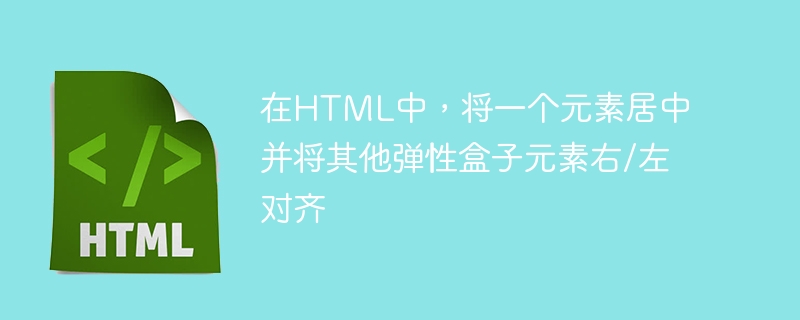在HTML中,将一个元素居中并将其他弹性盒子元素右/左对齐

Let’s say we have P, Q,R,S,T aligned in the center of a web page −
P Q R S T
我们希望上述内容保持不变,除了最右边的即T向右移动,像这样−
P Q R S T
现在让我们看一些例子来实现我们上面看到的。
Center one and right/ left align other flexbox element with auto margins
Example
的中文翻译为:示例
通过使用自动边距和一个新的、不可见的 flex 项,可以在网页上实现上述布局 −
<html>
<title>Example</title>
<head>
<style>
li:first-child {
margin-right: auto;
visibility: hidden;
}
li:last-child {
margin-left: auto;
background: orange;
}
ul {
padding: 0;
margin: 0;
display: flex;
flex-direction: row;
justify-content: center;
align-items: center;
}
li {
display: flex;
margin: 3px;
padding: 10px;
background: red;
}
p {
text-align: center;
margin-top: 0;
}
</style>
<head>
<body>
<ul>
<li>T</li>
<li>P</li>
<li>Q</li>
<li>R</li>
<li>S</li>
<li>T</li>
</ul>
</body>
<html>
Center one and right/ left align other flexbox element with pseudo element
在这个例子中,我们将使用与 T 相同宽度的伪元素。使用 ::before 将其放置在容器的开头。
Example
的中文翻译为:示例
让我们现在来看一个例子−
<html>
<title>Example</title>
<head>
<style>
ul::before {
content: "T";
margin: 1px auto 1px 1px;
visibility: hidden;
padding: 5px;
background: orange;
}
li:last-child {
margin-left: auto;
background: orange;
}
ul {
padding: 0;
margin: 0;
display: flex;
flex-direction: row;
justify-content: center;
align-items: center;
}
li {
display: flex;
margin: 3px;
padding: 10px;
background: red;
}
</style>
<head>
<body>
<ul>
<li>P</li>
<li>Q</li>
<li>R</li>
<li>S</li>
<li>T</li>
</ul>
</body>
<html>
Center one and right/ left align other flexbox element with Grid Layout
In this example, create a grid with multiple columns. Then position your items in the middle and end columns.
Example
的中文翻译为:示例
让我们现在来看一个例子−
<html>
<title>Example</title>
<head>
<style>
ul {
display: grid;
grid-template-columns: 1fr repeat(4, auto) 1fr;
grid-column-gap: 5px;
justify-items: center;
}
li:nth-child(1) {
grid-column-start: 2;
}
li:nth-child(5) {
margin-left: auto;
}
ul {
padding: 0;
margin: 0;
list-style: none;
}
li {
padding: 10px;
background: red;
}
p {
text-align: center;
}
</style>
<head>
<body>
<ul>
<li>P</li>
<li>Q</li>
<li>R</li>
<li>S</li>
<li>T</li>
</ul>
</body>
<html>
以上是在HTML中,将一个元素居中并将其他弹性盒子元素右/左对齐的详细内容。更多信息请关注PHP中文网其他相关文章!

热AI工具

Undresser.AI Undress
人工智能驱动的应用程序,用于创建逼真的裸体照片

AI Clothes Remover
用于从照片中去除衣服的在线人工智能工具。

Undress AI Tool
免费脱衣服图片

Clothoff.io
AI脱衣机

AI Hentai Generator
免费生成ai无尽的。

热门文章

热工具

记事本++7.3.1
好用且免费的代码编辑器

SublimeText3汉化版
中文版,非常好用

禅工作室 13.0.1
功能强大的PHP集成开发环境

Dreamweaver CS6
视觉化网页开发工具

SublimeText3 Mac版
神级代码编辑软件(SublimeText3)

热门话题
 C++对象布局与内存对齐,优化内存使用效率
Jun 05, 2024 pm 01:02 PM
C++对象布局与内存对齐,优化内存使用效率
Jun 05, 2024 pm 01:02 PM
C++对象布局和内存对齐优化内存使用效率:对象布局:数据成员按声明顺序存储,优化空间利用率。内存对齐:数据在内存中对齐,提升访问速度。alignas关键字指定自定义对齐,例如64字节对齐的CacheLine结构,提高缓存行访问效率。
 选择适合实现响应式布局的单位有哪些?
Jan 27, 2024 am 09:39 AM
选择适合实现响应式布局的单位有哪些?
Jan 27, 2024 am 09:39 AM
选择什么单位来实现响应式布局?随着移动设备和平板电脑的普及,越来越多的人使用各种设备来浏览网页。为了确保网页在不同设备上具有良好的可读性和用户体验,响应式布局逐渐成为了设计和开发中的重要考虑因素。而在实现响应式布局时,选择合适的单位非常重要。本文将分析几种常见的单位,以帮助读者选择合适的单位来实现响应式布局。像素(px):像素是最常见的长度单位,表示屏幕上一
 Photoshop对齐图层的操作步骤
Apr 01, 2024 am 11:31 AM
Photoshop对齐图层的操作步骤
Apr 01, 2024 am 11:31 AM
1、首先,我们需要打开Photoshop软件并进入界面,并且笔者将以如下图所示的图片为例进行图层之间对齐的演示。2、我们想要对齐图层,首先需要找到界面右下角的图层栏。3、然后,如果图层未进行栅格化或者解锁,我们需要右键选中图层进行栅格化或者双击进行解锁操作。4、接着,我们需要按住shift,进行需要对齐的图层的加选。5、最后,我们需要在工具栏中找到【选择】工具,并在上边的功能栏中找到对齐工具,我们点击想要对齐的方式,便可以快速对选中图层进行对齐了。
 CSS 文本属性优化技巧:字体、行高和文本对齐
Oct 22, 2023 am 08:15 AM
CSS 文本属性优化技巧:字体、行高和文本对齐
Oct 22, 2023 am 08:15 AM
CSS文本属性优化技巧:字体、行高和文本对齐在网页设计中,文本是不可或缺的一部分。通过优化CSS文本属性,我们可以提升网站的可读性和用户体验。本文将分享一些优化技巧,包括选择合适的字体、设置合理的行高和文本对齐方式,并提供具体的代码示例。一、选择合适的字体选择合适的字体对网页的可读性和视觉效果至关重要。以下是几个关键因素需要考虑:字体族:选择具备良好可
 使用CSS将flex项目对齐到容器的中心
Sep 19, 2023 pm 02:57 PM
使用CSS将flex项目对齐到容器的中心
Sep 19, 2023 pm 02:57 PM
使用值为center的justify-content属性将弹性项目对齐到中心。示例您可以尝试运行以下代码来实现中心值现场演示<!DOCTYPEhtml><html> <head> <style> .mycontainer{ &nbs
 对齐 HTML 文本的终极指南,打造整洁网页
Apr 09, 2024 pm 01:39 PM
对齐 HTML 文本的终极指南,打造整洁网页
Apr 09, 2024 pm 01:39 PM
对齐HTML文本可使用text-align属性(left、center、right、justify),CSSFlexbox(justify-content)和CSSGrid(grid-template-columns,justify-content)。具体选择取决于需求,如居中对齐标题(text-align或justify-content),两端对齐文本段落(justify),灵活响应图片画廊(justify-content动态调整对齐)。最佳实践强调语义化,根据需求选择,考虑设计具体需求(居中
 在HTML中,将一个元素居中并将其他弹性盒子元素右/左对齐
Sep 04, 2023 am 10:25 AM
在HTML中,将一个元素居中并将其他弹性盒子元素右/左对齐
Sep 04, 2023 am 10:25 AM
Let’ssaywehaveP,Q,R,S,Talignedinthecenterofawebpage−PQRST我们希望上述内容保持不变,除了最右边的即T向右移动,像这样−PQRST现在让我们看一些例子来实现我们上面看到的。Centeroneandright/leftalignotherflexboxelementwithautomarginsExample的中文翻译为:示例通过使用自动边距和一个新的、不可见的flex项,可以在网页上实现上述布局−<html>&am
 选择最适合你的响应式布局类型的方法
Feb 18, 2024 pm 04:19 PM
选择最适合你的响应式布局类型的方法
Feb 18, 2024 pm 04:19 PM
如何选择适合的响应式布局类型,需要具体代码示例随着移动设备的普及和互联网的飞速发展,响应式布局成为了网页设计的重要考虑因素。响应式布局能够根据不同的屏幕尺寸和设备类型,自动调整布局和内容的展示效果,提供更好的用户体验。然而,选择适合的响应式布局类型并不是一件容易的事情。本文将介绍几种常见的响应式布局类型,并给出相应的代码示例,希望能够帮助读者更好地选择适合自






